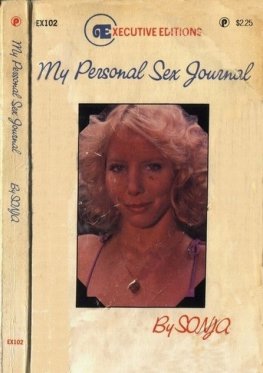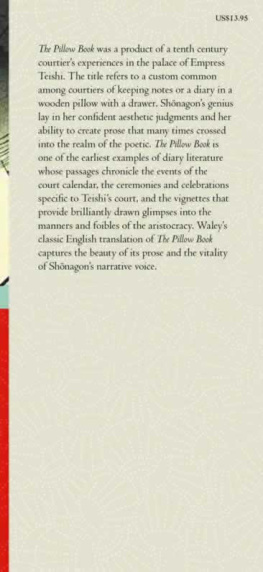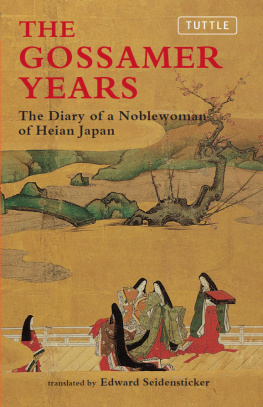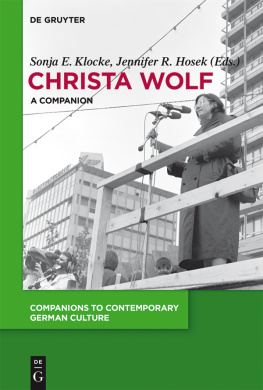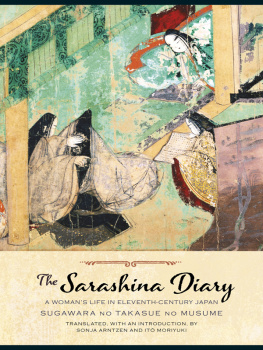Sonja Arntzen - The Kagero Diary: A Womans Autobiographical Text from Tenth-Century Japan
Here you can read online Sonja Arntzen - The Kagero Diary: A Womans Autobiographical Text from Tenth-Century Japan full text of the book (entire story) in english for free. Download pdf and epub, get meaning, cover and reviews about this ebook. year: 2020, publisher: University of Michigan Center for South and Southeast Asian Studies, genre: Detective and thriller. Description of the work, (preface) as well as reviews are available. Best literature library LitArk.com created for fans of good reading and offers a wide selection of genres:
Romance novel
Science fiction
Adventure
Detective
Science
History
Home and family
Prose
Art
Politics
Computer
Non-fiction
Religion
Business
Children
Humor
Choose a favorite category and find really read worthwhile books. Enjoy immersion in the world of imagination, feel the emotions of the characters or learn something new for yourself, make an fascinating discovery.

- Book:The Kagero Diary: A Womans Autobiographical Text from Tenth-Century Japan
- Author:
- Publisher:University of Michigan Center for South and Southeast Asian Studies
- Genre:
- Year:2020
- Rating:5 / 5
- Favourites:Add to favourites
- Your mark:
- 100
- 1
- 2
- 3
- 4
- 5
The Kagero Diary: A Womans Autobiographical Text from Tenth-Century Japan: summary, description and annotation
We offer to read an annotation, description, summary or preface (depends on what the author of the book "The Kagero Diary: A Womans Autobiographical Text from Tenth-Century Japan" wrote himself). If you haven't found the necessary information about the book — write in the comments, we will try to find it.
Sonja Arntzen: author's other books
Who wrote The Kagero Diary: A Womans Autobiographical Text from Tenth-Century Japan? Find out the surname, the name of the author of the book and a list of all author's works by series.
The Kagero Diary: A Womans Autobiographical Text from Tenth-Century Japan — read online for free the complete book (whole text) full work
Below is the text of the book, divided by pages. System saving the place of the last page read, allows you to conveniently read the book "The Kagero Diary: A Womans Autobiographical Text from Tenth-Century Japan" online for free, without having to search again every time where you left off. Put a bookmark, and you can go to the page where you finished reading at any time.
Font size:
Interval:
Bookmark:

The Kager Diary
Michigan Monographs in Japanese Studies
Number 19
Center for Japanese Studies
The University of Michigan
The Kager Diary
A Womans Autobiographical Text from Tenth-Century Japan
Translated with an Introduction and Notes by Sonja Arntzen
Center for Japanese Studies
The University of Michigan
Ann Arbor, 1997
Open access edition funded by the National Endowment for the Humanities / Andrew W. Mellon Foundation Humanities Open Book Program
1997 The Regents of the University of Michigan
All rights reserved
Published by the Center for Japanese Studies, The University of Michigan, 108 Lane Hall, 204 S. State Street, Ann Arbor, MI 48109-1290
Library of Congress Cataloging in Publication Division
Michitsuna no Haha, ca. 935-995.
[Kager nikki. English]
The Kager diary: a womans autobiographical text from tenth-century Japan / translated with an introduction and notes by Sonja Arntzen. xv, 415 p. 23.5 cm.(Michigan monograph series in Japanese studies ; no. 19)
Includes bibliographical references and index.
ISBN 0-939512-80-7 (cloth : alk. paper).ISBN 0-939512-81-5 (paper: alk. paper)
1. Michitsuna no Hahaca. 935-995Diaries. 2. Authors, JapaneseHeian period, 794-1185Diaries. I. Arntzen, Sonja, 1945-. II. Title. III. Series.
PL789.F8
895.6813dc21
[B]
97-15880
CIP
Jacket and cover illustration: Tale of Genji Screen (detail), Japanese, Edo period, early 17th century. One of a pair of six-panel screens, ink, colors, and gold on paper. Asian Art Museum of San Francisco, The Avery Brundage Collection (1991.65.1).
Jacket and cover design: Seiko Semones
This publication meets the ANSI/NISO Standards for Permanence of Paper for Publications and Documents in Libraries and Archives (Z39.481992).
Printed in the United States of America
ISBN 978-0-939512-80-5 (hardcover)
ISBN 978-0-939512-81-2 (paper)
ISBN 978-0-472-12745-0 (ebook)
ISBN 978-0-472-90140-1 (open access)
The text of this book is licensed under a Creative Commons Attribution-NonCommercial-NoDerivatives 4.0 International License: https://creativecommons.org/licenses/by-nc-nd/4.0/
Contents
.
.
.
.
.
.
.
.
.
.
.
.
.
.
.
All photos by the author, Sonja Arntzen.
The catalyst for the project to create a new translation of the Kager Diary came from my attending a conference at the University of Calgary in 1986, entitled, The Effect of the Feminist Approach on Research Methodologies. That conference opened up new fields of vision for me. In a word, what I saw was the possibility in exploring difference. I began to read Virgina Woolf, starting with A Room of Ones Own, and became intrigued with the question of whether there might be such a thing as a womans voice, language, and syntax. If such a distinction could be drawn, then classical Japanese literature of the Heian period (7941185), with its large number of foundational works by women, should be of great interest to the world. Moreover, when I was reading Woolf, I had an eerie sense that she was writing English in a style that had some affinity with the prose style shaped by classical Japanese women authors. At about the same time, I happened to hear the contemporary Canadian author, Daphne Marlatt, reading exceprts from her recently completed autobiographical novel, Ana Historic, and was even more struck by how the style of this author, who is very consciously exploring a womans voice, resonated with what I knew of classical Japanese womens writing.
Further reading brought awareness of questions that were engaging feminist critics, such as the construction of womens self in literature and the link between women writers and the autobiographical mode. Here again, Japanese classical literature of the Heian period is fertile material for study since it contains many autobiographical texts by women. As I read through books examining the relation between women and autobiography, I wondered why, except for a chapter by Richard Bowring in Domna Stantons The Female Autograph, the Japanese example was virtually unmentioned.
Intrigued to see whether the sense of similarity between the style of some modern feminist writers and that of Heian Japanese women would hold up under closer scrutiny, I decided to give a close reading tothe original of one of the Heian womens diaries, and I picked the Kager Diary as a place to start. I had not liked the text when I had read it many years ago in English translation, mainly because I thought the author complained too much, but I was aware nonetheless how extraordinary a text it was for its candor and acuteness of psychological observation. It seemed modern even though that term is so difficult to define. Contact with the original validated my initial perception of the affinity in womens prose styles across language and time and revealed a text of great beauty and complexity. I realized then that while The Gossamer Years, Edward Seidenstickers deft and clear translation of Kager nikki, conveyed the content of the text, it gave little sense of the style, and perhaps the style was critical. In the style was the material of interest to those engaging in questions of the construction of the female self in literature, the issue of truth and fiction in autobiography, and the distinctiveness of womans voice and language in literature. A new translation seemed essential.
I have broken with the long and distinguished tradition of translating the kager of the diary title as gossamer. Arthur Waley began the tradition by entitling his partial translation of Kager nikki the Gossamer Diary when he appended it to the second volume of his translation of the Tale of Genji (The Sacred Tree [Boston: Houghton Mifflin, 1926]). Edward Seidensticker followed Waleys lead on the reasonable justification that Waleys title makes up in poetic worth for what it lacks philologically (The Gossamer Years, p. 8) Recently, Helen McCullough has followed suit with the Gossamer Journal as the title for her translation of book one included in her Classical Japanese Prose: An Anthology (Stanford University Press, 1990). So why do I now fly in the face of a tradition established by those in the field whom I revere? It is just that I want to retain the complexity of the double meaning of kager. It means both mayfly and the shimmering of heat waves and thus stands for both the ephemerality of a life and its insubstantiality. The only way to keep the double meaning was to keep the word in Japanese and explain the complexity with a note. Clearly I cannot resort to this strategy often. If I did, I might as well give up translating entirely and take up a mission instead to teach the rest of the world classical Japanese. In this one instance, however, I trust it may be allowed, and should a non-Japanese reader want to speak about the text to a Japanese person, at least the title will be mutually understood.
As I worked on this translation, my sense of whom I wanted to share the translation with grew beyond specialists in the field of classical Japanese literature and critics interested in womens writing to include my friends, relatives, neighbors, and anyone interested in Japanese culture or literature in general. This has had ramifications on theprocess of the translation. Feeling a musical orality in the original, I wanted to have the translation sound well when read aloud. Thus, even at the early stages, I have read passages aloud to anyone who would listen. Somehow, due to this process, it has become a translation, I am told, that with its long, run-on sentences looks a little formidable on the page but makes sense when read aloud. Someone at a recent conference where I presented some of the translation even suggested publishing the text with an accompanying tape of it being read. I have not done that, but if, from time to time, readers find that the line of thought in a passage seems hard to follow, I would recommend trying to read it aloud.
Font size:
Interval:
Bookmark:
Similar books «The Kagero Diary: A Womans Autobiographical Text from Tenth-Century Japan»
Look at similar books to The Kagero Diary: A Womans Autobiographical Text from Tenth-Century Japan. We have selected literature similar in name and meaning in the hope of providing readers with more options to find new, interesting, not yet read works.
Discussion, reviews of the book The Kagero Diary: A Womans Autobiographical Text from Tenth-Century Japan and just readers' own opinions. Leave your comments, write what you think about the work, its meaning or the main characters. Specify what exactly you liked and what you didn't like, and why you think so.

